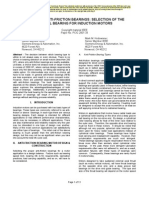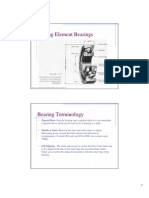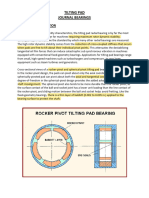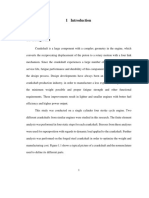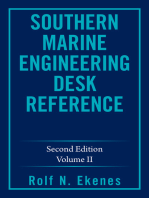CH 7 B
CH 7 B
Uploaded by
Zahidah AmaninaCopyright:
Available Formats
CH 7 B
CH 7 B
Uploaded by
Zahidah AmaninaOriginal Description:
Original Title
Copyright
Available Formats
Share this document
Did you find this document useful?
Is this content inappropriate?
Copyright:
Available Formats
CH 7 B
CH 7 B
Uploaded by
Zahidah AmaninaCopyright:
Available Formats
Variable Loading
Bearing loads are frequently variable and occur in some identifiable
patterns:
Piecewise constant loading in a cyclic pattern
Continuously variable loading in a repeatable cyclic pattern
Variable Loading with Piecewise Constant Loading
The loads Fei are equivalent steady radial loads for combined radial-thrust loads.
Variable Loading with Periodic Variation
Shigleys Mechanical Engineering Design
Variable Loading with Periodic Variation
Shigleys Mechanical Engineering Design
Selection of Ball and Cylindrical Roller Bearings
We have enough information concerning the loading of rolling-contact ball and roller
bearings to develop the steady equivalent radial load that will do as much damage to
the bearing as the existing loading. Now lets put it to work.
Example 11-7
shown in Figure 11-12 is a gear-driven squeeze roll that mates with an idler roll. The roll
is designed to exert a normal force of 5.25 N/mm of roll length and a pull of 4.2 N/mm on
the material being processed. The roll speed is 300 rev/min, and a design life of 30 kh is
desired. Use an application factor of 1.2, and select a pair of angular-contact 02-series ball
bearings from Table 11-2 to be mounted at 0 and A. Use the same size bearings at both
locations and combined reliablitiy of at least 0.92.
Shigleys Mechanical Engineering Design
Example 11-7
Example 11-7
Example 11-7
Shigleys Mechanical Engineering Design
Example 11-7
A 02-35 bearing will do.
Shigleys Mechanical Engineering Design
Bearing Lubrication
The purposes of bearing lubrication
To provide a film of lubricant between the sliding and rolling
surfaces
To help distribute and dissipate heat
To prevent corrosion of the bearing surfaces
To protect the parts from the entrance of foreign matter
Shigleys Mechanical Engineering Design
Bearing Lubrication
Either oil or grease may be used, with each having advantages in
certain situations.
Shigleys Mechanical Engineering Design
Some Common Bearing Mounting Configurations
Fig. 1120
The most frequently encountered mounting problem is that which requires one bearing
at each end of a shaft. Such a design might use one ball bearing at each end, one tapered
roller bearing at each end, or a ball bearing at one end and a straight roller bearing at the
other. One of the bearings usually has the added function of positioning or axially
locating the shaft. Figure 1120 shows a very common solution to this problem. The
inner rings are backed up against the shaft shoulders and are held in position by round
nuts threaded onto the shaft. The outer ring of the left-hand bearing is backed up against
a housing shoulder and is held in position by a device that is not shown. The outer ring
of the right-hand bearing floats in the housing.
Shigleys Mechanical Engineering Design
Some Common Bearing Mounting Configurations
Fig. 1121
Figure 1121 shows an alternative method of mounting in which the inner
races are backed up against the shaft shoulders as before but no retaining
devices are required. With this method the outer races are completely retained.
This eliminates the grooves or threads, which cause stress concentration on the
overhanging end, but it requires accurate dimensions in an axial direction or
the employment of adjusting means. This method has the disadvantage that if
the distance between the bearings is great, the temperature rise during
operation may expand the shaft enough to destroy the bearings.
Shigleys Mechanical Engineering Design
Some Common Bearing Mounting Configurations
Fig. 1122
It is frequently necessary to use two
or more bearings at one end of a
shaft. For example, two bearings
could be used to obtain additional
rigidity or increased load capacity or
to cantilever a shaft.
Shigleys Mechanical Engineering Design
Some Common Bearing Mounting Configurations
Fig. 1123
Shigleys Mechanical Engineering Design
Duplexing
When maximum stiffness and resistance to shaft misalignment is
desired, pairs of angular-contact bearings can be used in an
arrangement called duplexing.
Duplex bearings have rings ground with an offset.
When pairs are clamped together, a preload is established.
Shigleys Mechanical Engineering Design
Duplexing Arrangements
Three common duplexing arrangements:
(a) DF mounting Face to face, good for radial and thrust loads
from either direction
(b) DB mounting Back to back, same as DF, but with greater
alignment stiffness
(c) DT mounting Tandem, good for thrust only in one direction
Fig. 1124
Shigleys Mechanical Engineering Design
Preloading
Object of preloading
Remove internal clearance
Increase fatigue life
Decrease shaft slope at bearing
Fig. 1125
Shigleys Mechanical Engineering Design
Enclosures
Common shaft seals to exclude dirt and retain lubricant
Fig. 1126
Felt seals may be used with grease lubrication when the speeds are low. The
rubbing surfaces should have a high polish.
The commercial seal is an assembly consisting of the rubbing element and,
generally, a spring backing, which are retained in a sheet-metal jacket.
The labyrinth seal is especially effective for high-speed installations and may be
used with either oil or grease.
Shigleys Mechanical Engineering Design
You might also like
- Chevy Differentials: How to Rebuild the 10- and 12-BoltFrom EverandChevy Differentials: How to Rebuild the 10- and 12-BoltRating: 5 out of 5 stars5/5 (17)
- Sleeve Vs Antifriction Bearings Selection of The Optimal BearingDocument13 pagesSleeve Vs Antifriction Bearings Selection of The Optimal BearingKamal Arab50% (2)
- Bearings: IndexDocument9 pagesBearings: IndextanmayNo ratings yet
- Tripod Joint and Drive ShaftDocument10 pagesTripod Joint and Drive ShaftArnob DasNo ratings yet
- Producers Bank of The Philippines Vs CADocument2 pagesProducers Bank of The Philippines Vs CAMac100% (1)
- E204 S02 Exr DFTDocument8 pagesE204 S02 Exr DFTKantharaj Chinnappa100% (1)
- Bearings For Screw Drives - Just Bolt Them Down: Gerald Nonnast and Martin SchreiberDocument6 pagesBearings For Screw Drives - Just Bolt Them Down: Gerald Nonnast and Martin SchreiberMoustaffaNo ratings yet
- CH - 7 Shafts and Shaft ComponentsDocument52 pagesCH - 7 Shafts and Shaft ComponentsagniflameNo ratings yet
- BearingDocument41 pagesBearingM.IBRAHEEM100% (1)
- CH 11 SlidesDocument77 pagesCH 11 SlidestasrifNo ratings yet
- Ball BearingsDocument10 pagesBall BearingsAsst.Prof MECHNo ratings yet
- NBC Bearings TrainingDocument23 pagesNBC Bearings TrainingChiragJoshi25% (4)
- Bearings: Case of Shafts) or Free LinearDocument12 pagesBearings: Case of Shafts) or Free LinearsathishjeyNo ratings yet
- BearingsDocument23 pagesBearingsRakesh Nair ANo ratings yet
- Machine Design II Lecture#11-1Document32 pagesMachine Design II Lecture#11-1Muhammad ZubairNo ratings yet
- Chapter 5Document12 pagesChapter 5Fadhiran Yahya0% (1)
- Kami Export - Rolling Element Bearing-16!9!21Document38 pagesKami Export - Rolling Element Bearing-16!9!21Dr Atul WaghmareNo ratings yet
- Design of Machine Elements: MEPC24Document14 pagesDesign of Machine Elements: MEPC24Joe AllanNo ratings yet
- EML3500 CH 7 SlidesDocument108 pagesEML3500 CH 7 SlidesShitnu SuwanNo ratings yet
- Shafts and Shaft Components: Axle Is A Nonrotating Member That Carries No Torque and Is Used ToDocument12 pagesShafts and Shaft Components: Axle Is A Nonrotating Member That Carries No Torque and Is Used ToalhaggagiNo ratings yet
- ShigleyDocument3 pagesShigleynabaz muhamadNo ratings yet
- Front Axle (Automobile)Document14 pagesFront Axle (Automobile)priyeshdongreNo ratings yet
- Bbasics TranscriptDocument12 pagesBbasics TranscriptjoshuaNo ratings yet
- SKF Self Aligning BearingsDocument22 pagesSKF Self Aligning BearingsLL100% (1)
- Bearings: 7.0 Table of ContentsDocument16 pagesBearings: 7.0 Table of ContentsT ThirumuruganNo ratings yet
- Technical Information: Product Finder Home PageDocument6 pagesTechnical Information: Product Finder Home PageawemetalNo ratings yet
- Spherical Plain BearingsDocument8 pagesSpherical Plain Bearingsabooali_abbadan4684No ratings yet
- SKF Hub Bearing Units For Automotive and Industrial ApplicationsDocument17 pagesSKF Hub Bearing Units For Automotive and Industrial ApplicationsHector MaldonadoNo ratings yet
- Mech7350 13 Rolling Element BearingsDocument19 pagesMech7350 13 Rolling Element Bearingsfahrian05No ratings yet
- 4417 Self Aligning Bearing SystemDocument22 pages4417 Self Aligning Bearing SystemSayed KassarNo ratings yet
- BearingsDocument33 pagesBearingsBalasubramani SrinivasanNo ratings yet
- CH 1Document17 pagesCH 1joriecarlanonuevoNo ratings yet
- Wheel Set AssemblyDocument7 pagesWheel Set AssemblysumantlNo ratings yet
- Lecture Notes 2Document7 pagesLecture Notes 2Edwin kinyuaNo ratings yet
- Bearings - Rolling Contact BearingsDocument34 pagesBearings - Rolling Contact BearingsRohit GhulanavarNo ratings yet
- 2) Kalsoom BearingDocument18 pages2) Kalsoom BearingAjmal ArshadNo ratings yet
- What When How - Com Cylinder Block AutomobileDocument19 pagesWhat When How - Com Cylinder Block AutomobilerameshgmorayNo ratings yet
- BearingsDocument33 pagesBearingsRommel BlancoNo ratings yet
- Unit - 3 Design of BearingsDocument43 pagesUnit - 3 Design of BearingsCHANDRASEKARANNo ratings yet
- Principles and Use of Ball and Roller BearingsDocument76 pagesPrinciples and Use of Ball and Roller BearingsunfalsoimpostorNo ratings yet
- Machine Design Project IIDocument5 pagesMachine Design Project IIYigremachew bizualew AyenewNo ratings yet
- Bearing FitsDocument9 pagesBearing FitsPPMNo ratings yet
- CarbDocument84 pagesCarbJurun_BidanshiNo ratings yet
- Universal Joints (Automobile)Document15 pagesUniversal Joints (Automobile)Anoj pahathkumburaNo ratings yet
- Yaw BearingDocument6 pagesYaw BearingJuan CNo ratings yet
- Chapter-1: Design & Fabrication of Hydraulic Floor Crane 2014Document35 pagesChapter-1: Design & Fabrication of Hydraulic Floor Crane 2014Habtamu GeremewNo ratings yet
- Design and Fabrication of Hydraulic FlooDocument35 pagesDesign and Fabrication of Hydraulic FlooEric Rogers100% (1)
- Chapter-1: Design & Fabrication of Hydraulic Floor Crane 2014Document35 pagesChapter-1: Design & Fabrication of Hydraulic Floor Crane 2014Habtamu GeremewNo ratings yet
- Pulley Idler Shaft F9265C65B8F87Document3 pagesPulley Idler Shaft F9265C65B8F87souvonik100% (1)
- Slewing BearingDocument15 pagesSlewing BearingVenkatesh Kumar100% (1)
- Laughlin - A Comparison of Turbine Pulley Design Philosophies With Historical PerspectiveDocument3 pagesLaughlin - A Comparison of Turbine Pulley Design Philosophies With Historical Perspectivedarkwing888No ratings yet
- Crank ShaftDocument49 pagesCrank Shaftpramo_dassNo ratings yet
- Subframe To Body Mountings: Double Shear Paired Sandwich MountingDocument1 pageSubframe To Body Mountings: Double Shear Paired Sandwich Mountingsankarsuper83No ratings yet
- Practical Applications of Journal BearingsDocument16 pagesPractical Applications of Journal Bearingsgao379100% (1)
- Bearings And Bearing Metals: A Treatise Dealing with Various Types of Plain Bearings, the Compositions and Properties of Bearing Metals, Methods of Insuring Proper Lubrication, and Important Factors Governing the Design of Plain BearingsFrom EverandBearings And Bearing Metals: A Treatise Dealing with Various Types of Plain Bearings, the Compositions and Properties of Bearing Metals, Methods of Insuring Proper Lubrication, and Important Factors Governing the Design of Plain BearingsRating: 4 out of 5 stars4/5 (1)
- High Speed Off-Road Vehicles: Suspensions, Tracks, Wheels and DynamicsFrom EverandHigh Speed Off-Road Vehicles: Suspensions, Tracks, Wheels and DynamicsNo ratings yet
- Southern Marine Engineering Desk Reference: Second Edition Volume IiFrom EverandSouthern Marine Engineering Desk Reference: Second Edition Volume IiNo ratings yet
- How to Run a Lathe - Volume I (Edition 43) The Care and Operation of a Screw-Cutting LatheFrom EverandHow to Run a Lathe - Volume I (Edition 43) The Care and Operation of a Screw-Cutting LatheRating: 4.5 out of 5 stars4.5/5 (2)
- FYP General GuidelineDocument4 pagesFYP General GuidelineZahidah AmaninaNo ratings yet
- CNC Mill ProgrammingDocument24 pagesCNC Mill ProgrammingZahidah AmaninaNo ratings yet
- EME 2016 Chapter 2 - 1 Static LoadingDocument24 pagesEME 2016 Chapter 2 - 1 Static LoadingZahidah AmaninaNo ratings yet
- Procedure: No - DescriptionDocument4 pagesProcedure: No - DescriptionZahidah AmaninaNo ratings yet
- Determining The Scope of The Quality Management SystemDocument6 pagesDetermining The Scope of The Quality Management SystemNaeemNo ratings yet
- 8.4 Polar Bonds NewDocument25 pages8.4 Polar Bonds Newswailemnouf7No ratings yet
- Pass Leader DumpsDocument30 pagesPass Leader DumpsHyder BasetNo ratings yet
- 24 A - Review - On - The - Effect - of - Soil - Compaction - and - ItsDocument23 pages24 A - Review - On - The - Effect - of - Soil - Compaction - and - ItsLiv CBNo ratings yet
- Medical Opd FormDocument2 pagesMedical Opd FormSubhash RaoNo ratings yet
- Test 2Document23 pagesTest 2Hiếu EuroNo ratings yet
- Electrical Concepts: Why SF6 Gas Used in HV/EHV Circuit Breaker?Document3 pagesElectrical Concepts: Why SF6 Gas Used in HV/EHV Circuit Breaker?Sureshraja9977No ratings yet
- Member Data Record: Serviño, Ethel Rose CarmeloDocument1 pageMember Data Record: Serviño, Ethel Rose Carmeloethel rose servinoNo ratings yet
- FMDS0281Document67 pagesFMDS0281Sandeep YadavNo ratings yet
- Alonzo Ramos Factual ResumeDocument4 pagesAlonzo Ramos Factual ResumeThe Dallas Morning NewsNo ratings yet
- Mona Lisa Bonbon Cups RecipeDocument11 pagesMona Lisa Bonbon Cups RecipeAhmad AlayanNo ratings yet
- PhysicalSci12 Q1 Mod4 Week7 Sources of Energy v3Document33 pagesPhysicalSci12 Q1 Mod4 Week7 Sources of Energy v3Corazon ReymarNo ratings yet
- Making Sandwiches Libro Versión RevisadaDocument75 pagesMaking Sandwiches Libro Versión RevisadaRoderick Richmond100% (3)
- The Promise and The Potential of Digital Therapeutics DTX For DCDM 3hy96dDocument28 pagesThe Promise and The Potential of Digital Therapeutics DTX For DCDM 3hy96dNitin RoyNo ratings yet
- BoqDocument7 pagesBoqswatiNo ratings yet
- Search For The Higgs Boson in The H To W PDFDocument18 pagesSearch For The Higgs Boson in The H To W PDFManuelEduardoAndradePalmaNo ratings yet
- UNIT 02 TV Activity WorksheetsDocument3 pagesUNIT 02 TV Activity WorksheetsTriệu HảiNo ratings yet
- 比較nkc 9 and Amberlyst MainDocument11 pages比較nkc 9 and Amberlyst Maingg oggNo ratings yet
- ACCT403 - Practice Questions On OverheadDocument3 pagesACCT403 - Practice Questions On OverheadElle Amoah BoaduNo ratings yet
- KatarakDocument30 pagesKatarakdokter mudaNo ratings yet
- Amniotic Fluid Sludge Is Associated With Earlier Preterm Delivery and Raised Cervicovaginal Interleukin 8 ConcentrationsDocument7 pagesAmniotic Fluid Sludge Is Associated With Earlier Preterm Delivery and Raised Cervicovaginal Interleukin 8 ConcentrationsShinta Dewi WulandariNo ratings yet
- x50 M3u Links Tested Fnx20Document32 pagesx50 M3u Links Tested Fnx20Maverick ChukwuNo ratings yet
- Simple Past Tense - Regular VerbsDocument11 pagesSimple Past Tense - Regular VerbsFabi Usma PalacioNo ratings yet
- RCD AssignmentDocument3 pagesRCD AssignmentArj AsisNo ratings yet
- Sistem of EquetionDocument22 pagesSistem of EquetionArif KuncoroNo ratings yet
- Backyard BiologistDocument2 pagesBackyard Biologistapi-234287636No ratings yet
- Technical Specification For The Purchase of 1 Unit of 240HP Crawler TractorDocument14 pagesTechnical Specification For The Purchase of 1 Unit of 240HP Crawler TractoragegnehutamiratNo ratings yet
- Olanzapine Vs AripiprazoleDocument8 pagesOlanzapine Vs AripiprazoleDivaviyaNo ratings yet
- ApacheHVAC User Guide - Virtual Environment - 6.1Document188 pagesApacheHVAC User Guide - Virtual Environment - 6.1leungNo ratings yet

